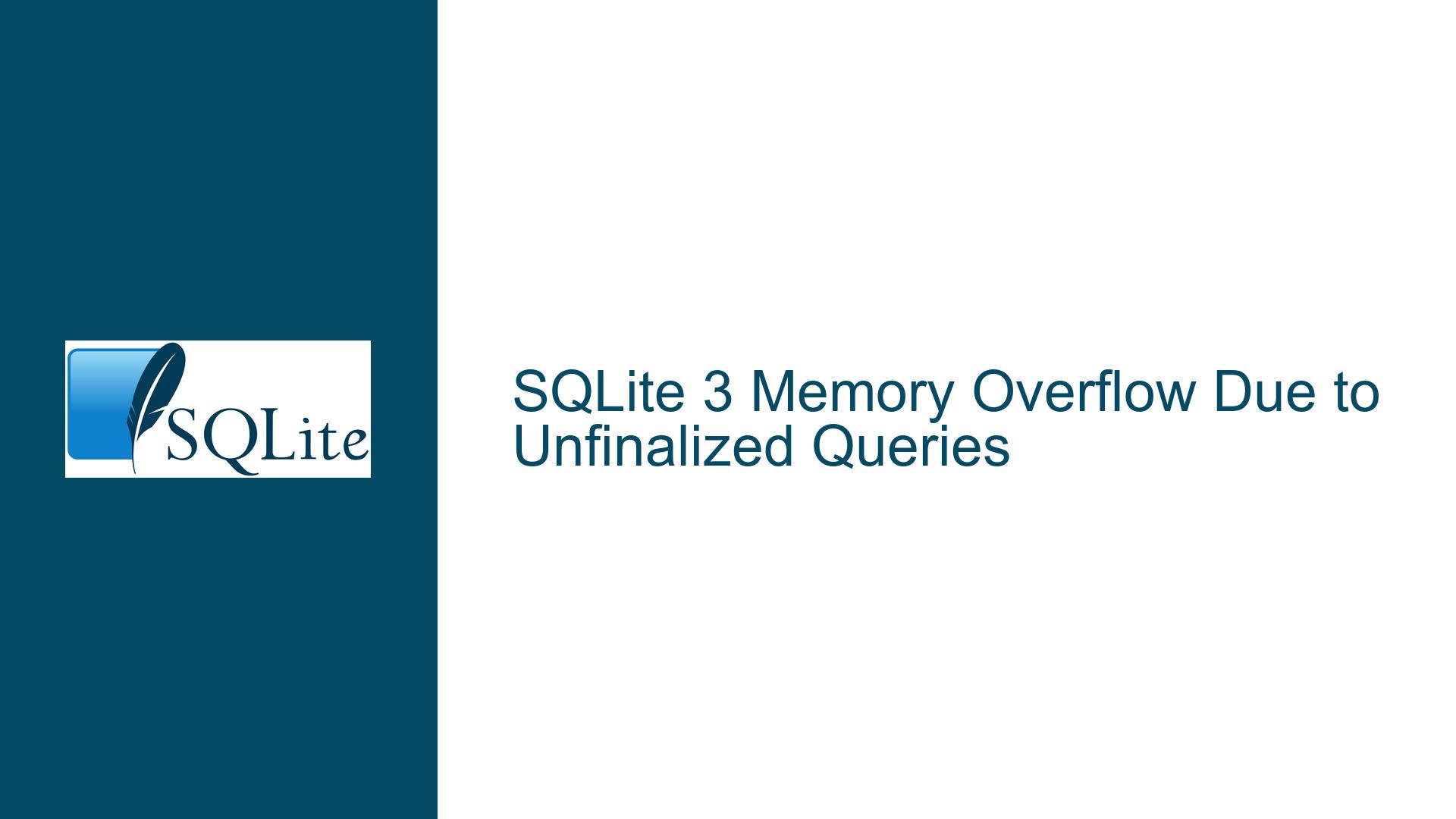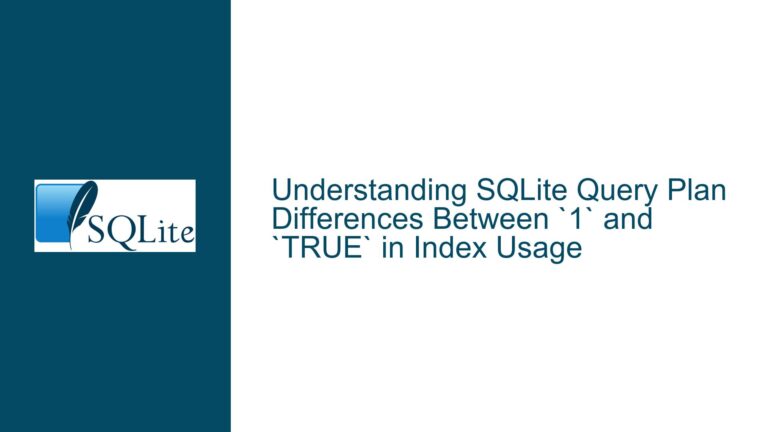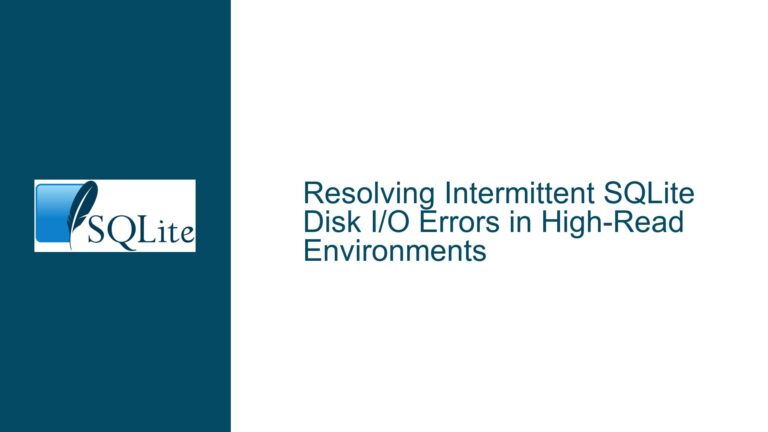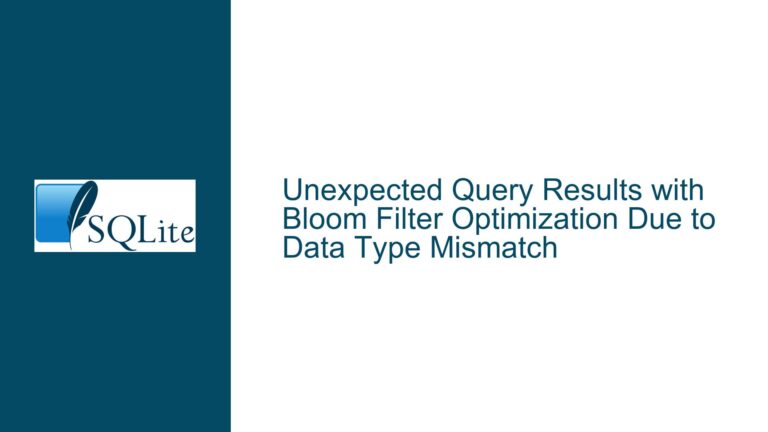SQLite 3 Memory Overflow Due to Unfinalized Queries
SQLite Memory Management and Unfinalized Queries
SQLite is a lightweight, serverless, and self-contained database engine that is widely used in embedded systems, mobile applications, and even large-scale applications where simplicity and efficiency are paramount. One of SQLite’s strengths is its robust memory management system, which is designed to minimize memory leaks and ensure efficient resource utilization. However, like any software, SQLite is not immune to issues arising from improper usage, particularly when it comes to memory management. One such issue is memory overflow caused by unfinalized queries, which can lead to significant memory consumption over time, especially in long-running processes.
In this post, we will delve into the intricacies of SQLite’s memory management, explore the causes of memory overflow due to unfinalized queries, and provide detailed troubleshooting steps and solutions to address this issue. By the end of this guide, you will have a comprehensive understanding of how to diagnose and resolve memory overflow problems in SQLite, ensuring that your applications run efficiently and reliably.
Possible Causes of Memory Overflow in SQLite
Memory overflow in SQLite can be attributed to several factors, but one of the most common causes is the failure to finalize queries. When a query is executed in SQLite, memory is allocated to store the query’s state, results, and associated resources. This memory is typically released when the query is finalized, either explicitly by the application or implicitly when the query object is garbage collected. However, if a query is not finalized, the memory associated with it remains allocated, leading to a gradual increase in memory usage over time.
Another potential cause of memory overflow is the improper handling of database connections. SQLite uses a connection-based model, where each connection to the database is associated with its own set of resources, including memory for caching, prepared statements, and other internal structures. If connections are not properly closed or reused, memory leaks can occur, leading to increased memory consumption.
Additionally, the use of shared memory-mapped files (SHM) in SQLite can contribute to memory overflow. SQLite uses SHM files to manage concurrent access to the database in WAL (Write-Ahead Logging) mode. If these files are not properly managed or cleaned up, they can lead to memory fragmentation and increased memory usage.
Finally, the behavior of the underlying operating system and the environment in which SQLite is running can also impact memory management. For example, running SQLite in a containerized environment, such as Docker, can introduce additional complexities in memory allocation and deallocation, particularly if the container’s memory limits are not properly configured.
Diagnosing and Resolving Memory Overflow in SQLite
To diagnose and resolve memory overflow issues in SQLite, it is essential to follow a systematic approach that includes monitoring memory usage, identifying the root cause of the issue, and implementing appropriate fixes. Below, we outline a detailed set of troubleshooting steps and solutions to address memory overflow caused by unfinalized queries and other related factors.
Step 1: Monitor Memory Usage
The first step in diagnosing memory overflow is to monitor the memory usage of your application and the SQLite database. This can be done using a combination of system-level tools and SQLite-specific commands.
System-Level Monitoring: Use tools like
docker stats,pmap, andjmapto monitor the memory usage of your container, process, and Java application, respectively. These tools provide insights into the overall memory consumption and help identify any discrepancies between the memory usage reported by the application and the underlying system.SQLite-Specific Monitoring: SQLite provides several PRAGMA statements and built-in functions that can be used to monitor memory usage. For example, the
sqlite3_memory_used()function returns the amount of memory currently allocated by SQLite, while thesqlite3_status()function provides detailed information about memory usage and other internal states.
Step 2: Identify Unfinalized Queries
Once you have identified that memory overflow is occurring, the next step is to determine whether unfinalized queries are the root cause. This can be done by examining the application code and the SQLite logs.
Code Review: Review the application code to ensure that all queries are properly finalized. In SQLite, queries are typically finalized using the
sqlite3_finalize()function. If you are using a higher-level library or framework, such as JDBC, ensure that the library’s API is being used correctly to finalize queries.SQLite Logs: Enable SQLite’s logging functionality to capture detailed information about query execution and memory allocation. The
sqlite3_trace()function can be used to log all SQL statements executed by the database, while thesqlite3_config(SQLITE_CONFIG_LOG, ...)function can be used to log internal SQLite events, including memory allocation and deallocation.
Step 3: Finalize Queries Properly
If unfinalized queries are identified as the cause of memory overflow, the next step is to ensure that all queries are properly finalized. This involves modifying the application code to explicitly finalize queries after they have been executed.
Explicit Finalization: In SQLite, queries should be finalized using the
sqlite3_finalize()function. This function releases all resources associated with the query, including memory allocated for the query’s state and results. If you are using a higher-level library, such as JDBC, ensure that the library’s API is being used correctly to finalize queries.Resource Management: Implement proper resource management practices in your application to ensure that all database resources, including queries, connections, and statements, are properly closed and finalized. This can be done using try-with-resources blocks in Java or similar constructs in other programming languages.
Step 4: Optimize Database Connections
Improper handling of database connections can also contribute to memory overflow. To address this, optimize the way your application manages database connections.
Connection Pooling: Use connection pooling to manage database connections efficiently. Connection pooling allows you to reuse existing connections rather than creating new ones for each query, reducing the overhead associated with establishing and tearing down connections.
Connection Limits: Set limits on the number of concurrent database connections to prevent excessive memory usage. This can be done using SQLite’s
sqlite3_limit()function or by configuring connection pooling settings in your application.
Step 5: Manage Shared Memory-Mapped Files
If your application is using SQLite’s WAL mode, it is important to properly manage shared memory-mapped files (SHM) to avoid memory fragmentation and overflow.
SHM File Cleanup: Ensure that SHM files are properly cleaned up when they are no longer needed. This can be done by closing database connections and ensuring that the database is properly shut down.
WAL Mode Configuration: Configure SQLite’s WAL mode settings to optimize memory usage. For example, you can adjust the size of the WAL file using the
sqlite3_wal_autocheckpoint()function or by setting thePRAGMA wal_autocheckpointstatement.
Step 6: Optimize the Operating System and Environment
Finally, optimize the operating system and environment in which SQLite is running to ensure efficient memory management.
Container Configuration: If you are running SQLite in a containerized environment, such as Docker, ensure that the container’s memory limits are properly configured. Use tools like
docker statsto monitor the container’s memory usage and adjust the container’s memory limits as needed.Operating System Tuning: Tune the operating system’s memory management settings to optimize performance and prevent memory fragmentation. This may involve adjusting kernel parameters, such as
vm.swappiness, or configuring memory limits for processes.
Conclusion
Memory overflow in SQLite can be a challenging issue to diagnose and resolve, particularly when it is caused by unfinalized queries or improper resource management. By following the detailed troubleshooting steps and solutions outlined in this guide, you can effectively identify and address the root causes of memory overflow, ensuring that your SQLite-based applications run efficiently and reliably.
Remember that SQLite’s memory management is highly robust, but it relies on proper usage and resource management by the application. By adopting best practices for query finalization, connection management, and environment optimization, you can prevent memory overflow and ensure that your SQLite databases perform optimally in even the most demanding scenarios.






